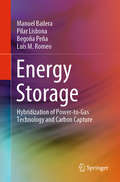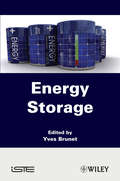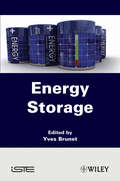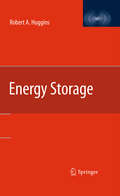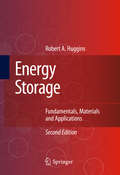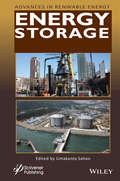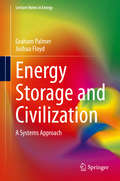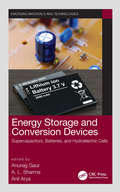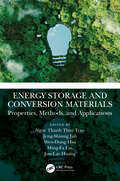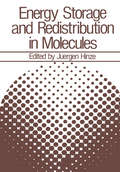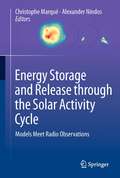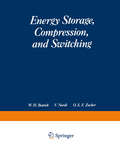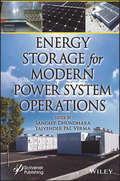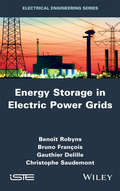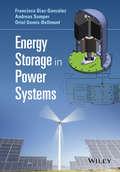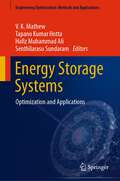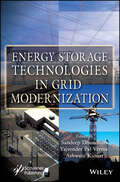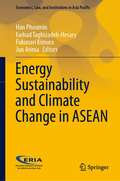- Table View
- List View
Energy Storage: Hybridization of Power-to-Gas Technology and Carbon Capture (Springerbriefs In Energy Ser.)
by Manuel Bailera Pilar Lisbona Begoña Peña Luis M. RomeoThis book presents a detailed analysis of Power-to-Gas, a promising energy storage technology. It discusses the main mechanisms involved, and presents two Power-to-Gas and carbon capture hybridizations. The book begins by providing an introduction to energy storage technologies. It then reviews a number of Power-to-Gas projects now in progress, highlighting the current barriers to commercializing the technology. Moreover, the book presents two novel Power-to-Gas hybridizations, which improve the technology’s applicability in terms of efficiency, utilization of resources and profitability. Given its scope, the book will be of interest to graduate students, researchers and practitioners in the fields of engineering and energy.
Energy Storage
by Yves BrunetEnergy storage examines different applications such as electric power generation, transmission and distribution systems, pulsed systems, transportation, buildings and mobile applications. For each of these applications, proper energy storage technologies are foreseen, with their advantages, disadvantages and limits. As electricity cannot be stored cheaply in large quantities, energy has to be stored in another form (chemical, thermal, electromagnetic, mechanical) and then converted back into electric power and/or energy using conversion systems. Most of the storage technologies are examined: batteries, hydrogen, super capacitors, SMES, flywheels, CAES, thermal storage and hydraulic gravitational storage.
Energy Storage
by Yves BrunetEnergy storage examines different applications such as electric power generation, transmission and distribution systems, pulsed systems, transportation, buildings and mobile applications. For each of these applications, proper energy storage technologies are foreseen, with their advantages, disadvantages and limits. As electricity cannot be stored cheaply in large quantities, energy has to be stored in another form (chemical, thermal, electromagnetic, mechanical) and then converted back into electric power and/or energy using conversion systems. Most of the storage technologies are examined: batteries, hydrogen, super capacitors, SMES, flywheels, CAES, thermal storage and hydraulic gravitational storage.
Energy Storage: Fundamentals, Materials And Applications
by Robert HugginsIntroduction Energy is necessary for a number of reasons, the most basic and obvious involve the preparation of food and the provision of heat to make life comfortable, or at least, bearable. Subsequently, a wide range of technological uses of energy have emerged and been developed, so that the availability of energy has become a central issue in society. The easiest way to acquire useful energy is to simply ?nd it as wood or a hydrocarbon fossil fuel in nature. But it has often been found to be advantageous to convert what is simply available in nature into more useful forms, and the processing and conversion of raw materials, especially petrochemicals have become a very large industry. Wood Wood has been used to provide heat for a great many years. In some cases, it can be acquired as needed by foraging, or cutting, followed by simple collection. When it is abundant there is relatively little need for it to be stored. However, many societies have found it desirable to collect more wood than is immediately needed during warm periods during the year, and to store it up for use in the winter, when the needs are greater, or its collection is not so convenient. One can still see this in some locations, such as the more remote communities in the Alps, for example. One might think of this as the oldest and simplest example of energy storage.
Energy Storage: Fundamentals, Materials and Applications
by Robert HugginsEnergy Storage explains the underlying scientific and engineering fundamentals of all major energy storage methods. These include the storage of energy as heat, in phase transitions and reversible chemical reactions, and in organic fuels and hydrogen, as well as in mechanical, electrostatic and magnetic systems. Updated coverage of electrochemical storage systems considers exciting developments in materials and methods for applications such as rapid short-term storage in hybrid and intermittent energy generation systems, and battery optimization for increasingly prevalent EV and stop-start automotive technologies. This nuanced coverage of cutting-edge advances is unique in that it does not require prior knowledge of electrochemistry. Traditional and emerging battery systems are explained, including lithium, flow and liquid batteries. Energy Storage provides a comprehensive overview of the concepts, principles and practice of energy storage that is useful to both students and professionals.
Energy Storage (Advances In Renewable Energy Ser.)
by Umakanta SahooThe world’s energy landscape is very complex. Fossil fuels, especially because of hydraulic fracturing, are still a mainstay of global energy production, but renewable energy sources, such as wind, solar, and others, are increasing in importance for global energy sustainability. Experts and non-experts agree that the next game-changer in this area will be energy storage. Energy storage is crucial for continuous operation of power plants and can supplement basic power generation sources over a stand-alone system. It can enhance capacity and leads to greater security, including continuous electricity supply and other applications. A dependable energy storage system not only guarantees that the grid will not go down, but also increases efficacy and efficiency of any energy system. This groundbreaking new volume in this forward thinking series addresses all of these issues, laying out the latest advances and addressing the most serious current concerns in energy storage. Whether for the veteran engineer or the student, this latest volume in the series, “Advances in Renewable Energy,” is a must-have for any library.
Energy Storage (Advances In Renewable Energy Ser.)
by Umakanta SahooThe world’s energy landscape is very complex. Fossil fuels, especially because of hydraulic fracturing, are still a mainstay of global energy production, but renewable energy sources, such as wind, solar, and others, are increasing in importance for global energy sustainability. Experts and non-experts agree that the next game-changer in this area will be energy storage. Energy storage is crucial for continuous operation of power plants and can supplement basic power generation sources over a stand-alone system. It can enhance capacity and leads to greater security, including continuous electricity supply and other applications. A dependable energy storage system not only guarantees that the grid will not go down, but also increases efficacy and efficiency of any energy system. This groundbreaking new volume in this forward thinking series addresses all of these issues, laying out the latest advances and addressing the most serious current concerns in energy storage. Whether for the veteran engineer or the student, this latest volume in the series, “Advances in Renewable Energy,” is a must-have for any library.
Energy Storage and Civilization: A Systems Approach (Lecture Notes in Energy #40)
by Graham Palmer Joshua FloydFossil fuels comprise the accumulation of prehistoric biomass that was energised by sunlight, and formed by earth system dynamics. Fossil fuels can be conceptualized as stored energy stocks that can be readily converted to power flows, on demand. A transition from a reliance on stored energy stocks, to renewable energy flows, will require a replication of energy storage by technological devices and energy conversion methods. Most analyses of energy storage focus solely on the economic-technical properties of storage within incumbent energy systems. This book broadens the scope of the study of storage by placing it within a broader, historical, biophysical framework. The role and value of storage is examined from first principles, and framed within the contemporary context of electrical grids and markets. The energy-economic cost of electrical storage may be critical to the efficacy of high penetration renewable scenarios, and understanding the costs and benefits of storage is needed for a proper assessment of storage in energy transition studies. This book provides a starting point for engineers, scientists and energy analysts for exploring the role of storage in energy transition studies, and for gaining an appreciation of the biophysical constraints of storage.
Energy Storage and Conversion Devices: Supercapacitors, Batteries, and Hydroelectric Cells (Emerging Materials and Technologies)
by Anurag GaurThis book presents a state-of-the-art overview of the research and development in designing electrode and electrolyte materials for Li-ion batteries and supercapacitors. Further, green energy production via the water splitting approach by the hydroelectric cell is also explored. Features include: • Provides details on the latest trends in design and optimization of electrode and electrolyte materials with key focus on enhancement of energy storage and conversion device performance • Focuses on existing nanostructured electrodes and polymer electrolytes for device fabrication, as well as new promising research routes toward the development of new materials for improving device performance • Features a dedicated chapter that explores electricity generation by dissociating water through hydroelectric cells, which are a nontoxic and green source of energy production • Describes challenges and offers a vision for next-generation devices This book is beneficial for advanced students and professionals working in energy storage across the disciplines of physics, materials science, chemistry, and chemical engineering. It is also a valuable reference for manufacturers of electrode/electrolyte materials for energy storage devices and hydroelectric cells.
Energy Storage and Conversion Devices: Supercapacitors, Batteries, and Hydroelectric Cells (Emerging Materials and Technologies)
by Anurag Gaur A. L. Sharma Anil AryaThis book presents a state-of-the-art overview of the research and development in designing electrode and electrolyte materials for Li-ion batteries and supercapacitors. Further, green energy production via the water splitting approach by the hydroelectric cell is also explored. Features include: • Provides details on the latest trends in design and optimization of electrode and electrolyte materials with key focus on enhancement of energy storage and conversion device performance • Focuses on existing nanostructured electrodes and polymer electrolytes for device fabrication, as well as new promising research routes toward the development of new materials for improving device performance • Features a dedicated chapter that explores electricity generation by dissociating water through hydroelectric cells, which are a nontoxic and green source of energy production • Describes challenges and offers a vision for next-generation devices This book is beneficial for advanced students and professionals working in energy storage across the disciplines of physics, materials science, chemistry, and chemical engineering. It is also a valuable reference for manufacturers of electrode/electrolyte materials for energy storage devices and hydroelectric cells.
Energy Storage and Conversion Materials: Properties, Methods, and Applications
by Tran, Ngoc Thanh Thuy Jeng-Shiung Jan Wen-Dung Hsu Ming-Fa Lin Jow-Lay HuangThis book explores the fundamental properties of a wide range of energy storage and conversion materials, covering mainstream theoretical and experimental studies and their applications in green energy. It presents a thorough investigation of diverse physical, chemical, and material properties of rechargeable batteries, supercapacitors, solar cells, and fuel cells, covering the development of theoretical simulations, machine learning, high-resolution experimental measurements, and excellent device performance. Covers potential energy storage (rechargeable batteries and supercapacitors) and energy conversion (solar cells and fuel cells) materials Develops theoretical predictions and experimental observations under a unified quasi-particle framework Illustrates up-to-date calculation results and experimental measurements Describes successful synthesis, fabrication, and measurements, as well as potential applications and near-future challenges Promoting a deep understanding of basic science, application engineering, and commercial products, this work is appropriate for senior graduate students and researchers in materials, chemical, and energy engineering and related disciplines.
Energy Storage and Conversion Materials: Properties, Methods, and Applications
This book explores the fundamental properties of a wide range of energy storage and conversion materials, covering mainstream theoretical and experimental studies and their applications in green energy. It presents a thorough investigation of diverse physical, chemical, and material properties of rechargeable batteries, supercapacitors, solar cells, and fuel cells, covering the development of theoretical simulations, machine learning, high-resolution experimental measurements, and excellent device performance. Covers potential energy storage (rechargeable batteries and supercapacitors) and energy conversion (solar cells and fuel cells) materials Develops theoretical predictions and experimental observations under a unified quasi-particle framework Illustrates up-to-date calculation results and experimental measurements Describes successful synthesis, fabrication, and measurements, as well as potential applications and near-future challenges Promoting a deep understanding of basic science, application engineering, and commercial products, this work is appropriate for senior graduate students and researchers in materials, chemical, and energy engineering and related disciplines.
Energy Storage and Redistribution in Molecules
by Jürgen HinzeWe characterize an isolated molecule by its compos~t~on, i.e. the number and types of atoms forming the molecule, its structure, i.e. the geometrical arrangement of the composite atoms with respect to each other, and its possible, i.e. quantum mechanically allowed, stationary energy states. Conceptually we separate the latter, being aware that this is an approximation, into electronic, vibrational and rotational states, including fine and hyperfine structure splittings. To be sure, there is an intimate relation between molecular structure and molecular energy states, in fact it is this relation we use, when we obtain structural information through spectroscopy, where we determine transitions between various stationary states of the molecule. The concepts above have proven extremely useful in chemistry and spectroscopy, however, the awareness of the limitations of these concepts has grown in recent years with the increasing recognition of (i) fluctional molecules, (ii) multiphoton absorption processes and (iii) influences due to the surroundings on "isolated" molecules.
Energy Storage and Release through the Solar Activity Cycle: Models Meet Radio Observations
by Alexander Nindos Christophe MarqueFor nearly sixty years, radio observations have provided a unique insight into the physics of the active and quiescent solar atmosphere. Thanks to the variety of emission mechanisms and to the large altitude range available to observations, fundamental plasma parameters have been measured from the low chromosphere to the upper corona and interplanetary medium. This book presents current research in solar radio astronomy and shows how well it fits in the exceptional scientific context brought by the current space solar observatories. It essentially contains contributed research and review papers presented during the 2010 Community of European Solar Radio Astronomers (CESRA) meeting, which took place in Belgium in June 2010. This book is aimed at graduate students and researchers working in solar physics and space science. Previously published in Solar Physics journal, Vol. 273/2, 2011.
Energy Storage, Compression, and Switching
by W. BostickThis international conference was organized by the sponsoring agencies with the following objectives in mind: to bring together active researchers involved in energy compression, switching, and storage who have a major interest in plasma physics, electron beams, electric and magnetic energy storage systems, and high voltage and high current switches. Areas of interest include: Slow systems: 50-60 Hz machinery, transformers, flywheel-homopolar generators, slow capacitors, inductors, and solid state switches. Inter mediate systems: fast capacitor banks, superconducting storage and switch ing, gas, vacuum, and dielectric switching, nonlinear (magnetic) switching, 5 6 fast (10 - 10 Hz) capacitors and fuses. Fast systems: Marx, Blumlein, oil, water, and pressurized water dielectrics, switches, magnetic insula tion, electron beams, and plasmas. The Editors extend thanks to all the authors, and attendees (and their supporting institutions, and companies), everyone of whom in his own measure helped to make the conference a success. The Editors further wish to thank the members of the Scientific Committee for the help they have given in organizing the conference and in editing, especially J. C. Martin and H. L. Laquer. Special recognition is due the Lawrence Livermore Laboratory whose Electrical Engineering Department provided the Secretary of the Scientific Committee and one of the Editors, and the yeowoman services of Sharon Dodson and Cheri Johnson in all the mailings, correspondence, and receiving and organizing of the manuscripts. The LLL Technical Information Department provided the design and printing of the conference announcements and the instructional formats for the authors' manuscripts.
Energy Storage for Modern Power System Operations
by Sandeep Dhundhara Yajvender Pal VermaENERGY STORAGE for MODERN POWER SYSTEM OPERATIONS Written and edited by a team of well-known and respected experts in the field, this new volume on energy storage presents the state-of-the-art developments and challenges for modern power systems for engineers, researchers, academicians, industry professionals, consultants, and designers. Energy storage systems have been recognized as the key elements in modern power systems, where they are able to provide primary and secondary frequency controls, voltage regulation, power quality improvement, stability enhancement, reserve service, peak shaving, and so on. Particularly, deployment of energy storage systems in a distributed manner will contribute greatly in the development of smart grids and providing promising solutions for the above issues. The main challenges will be the adoption of new techniques and strategies for the optimal planning, control, monitoring and management of modern power systems with the wide installation of distributed energy storage systems. Thus, the aim of this book is to illustrate the potential of energy storage systems in different applications of modern power systems, with a view toward illuminating recent advances and research trends in storage technologies. This exciting new volume covers the recent advancements and applications of different energy storage technologies that are useful to engineers, scientists, and students in the discipline of electrical engineering. Suitable for the engineers at power companies and energy storage consultants working in the energy storage field, this book offers a cross-disciplinary look across electrical, mechanical, chemical and renewable engineering aspects of energy storage. Whether for the veteran engineer or the student, this is a must-have for any library. AUDIENCE Electrical engineers and other designers, engineers, and scientists working in energy storage
Energy Storage for Modern Power System Operations
by Sandeep Dhundhara Yajvender Pal VermaENERGY STORAGE for MODERN POWER SYSTEM OPERATIONS Written and edited by a team of well-known and respected experts in the field, this new volume on energy storage presents the state-of-the-art developments and challenges for modern power systems for engineers, researchers, academicians, industry professionals, consultants, and designers. Energy storage systems have been recognized as the key elements in modern power systems, where they are able to provide primary and secondary frequency controls, voltage regulation, power quality improvement, stability enhancement, reserve service, peak shaving, and so on. Particularly, deployment of energy storage systems in a distributed manner will contribute greatly in the development of smart grids and providing promising solutions for the above issues. The main challenges will be the adoption of new techniques and strategies for the optimal planning, control, monitoring and management of modern power systems with the wide installation of distributed energy storage systems. Thus, the aim of this book is to illustrate the potential of energy storage systems in different applications of modern power systems, with a view toward illuminating recent advances and research trends in storage technologies. This exciting new volume covers the recent advancements and applications of different energy storage technologies that are useful to engineers, scientists, and students in the discipline of electrical engineering. Suitable for the engineers at power companies and energy storage consultants working in the energy storage field, this book offers a cross-disciplinary look across electrical, mechanical, chemical and renewable engineering aspects of energy storage. Whether for the veteran engineer or the student, this is a must-have for any library. AUDIENCE Electrical engineers and other designers, engineers, and scientists working in energy storage
Energy Storage in Electric Power Grids
by Benoît Robyns Bruno François Gauthier Delille Christophe SaudemontThis book deals with the management and valuation of energy storage in electric power grids, highlighting the interest of storage systems in grid applications and developing management methodologies based on artificial intelligence tools. The authors highlight the importance of storing electrical energy, in the context of sustainable development, in "smart grids", and discuss multiple services that storing electrical energy can bring. Methodological tools are provided to build an energy management system storage following a generic approach. These tools are based on causal formalisms, artificial intelligence and explicit optimization techniques and are presented throughout the book in connection with concrete case studies.
Energy Storage in Electric Power Grids
by Benoît Robyns Bruno François Gauthier Delille Christophe SaudemontThis book deals with the management and valuation of energy storage in electric power grids, highlighting the interest of storage systems in grid applications and developing management methodologies based on artificial intelligence tools. The authors highlight the importance of storing electrical energy, in the context of sustainable development, in "smart grids", and discuss multiple services that storing electrical energy can bring. Methodological tools are provided to build an energy management system storage following a generic approach. These tools are based on causal formalisms, artificial intelligence and explicit optimization techniques and are presented throughout the book in connection with concrete case studies.
Energy Storage in Power Systems
by Francisco Díaz-González Andreas Sumper Oriol Gomis-BellmuntOver the last century, energy storage systems (ESSs) have continued to evolve and adapt to changing energy requirements and technological advances. Energy Storage in Power Systems describes the essential principles needed to understand the role of ESSs in modern electrical power systems, highlighting their application for the grid integration of renewable-based generation. Key features: Defines the basis of electrical power systems, characterized by a high and increasing penetration of renewable-based generation. Describes the fundamentals, main characteristics and components of energy storage technologies, with an emphasis on electrical energy storage types. Contains real examples depicting the application of energy storage systems in the power system. Features case studies with and without solutions on modelling, simulation and optimization techniques. Although primarily targeted at researchers and senior graduate students, Energy Storage in Power Systems is also highly useful to scientists and engineers wanting to gain an introduction to the field of energy storage and more specifically its application to modern power systems.
Energy Storage in Power Systems
by Francisco Díaz-González Andreas Sumper Oriol Gomis-BellmuntOver the last century, energy storage systems (ESSs) have continued to evolve and adapt to changing energy requirements and technological advances. Energy Storage in Power Systems describes the essential principles needed to understand the role of ESSs in modern electrical power systems, highlighting their application for the grid integration of renewable-based generation. Key features: Defines the basis of electrical power systems, characterized by a high and increasing penetration of renewable-based generation. Describes the fundamentals, main characteristics and components of energy storage technologies, with an emphasis on electrical energy storage types. Contains real examples depicting the application of energy storage systems in the power system. Features case studies with and without solutions on modelling, simulation and optimization techniques. Although primarily targeted at researchers and senior graduate students, Energy Storage in Power Systems is also highly useful to scientists and engineers wanting to gain an introduction to the field of energy storage and more specifically its application to modern power systems.
Energy Storage Systems: Optimization and Applications (Engineering Optimization: Methods and Applications)
by Hafiz Muhammad Ali Tapano Kumar Hotta V. K. Mathew Senthilarasu SundaramThis book discusses generalized applications of energy storage systems using experimental, numerical, analytical, and optimization approaches. The book includes novel and hybrid optimization techniques developed for energy storage systems. It provides a range of applications of energy storage systems on a single platform. The book broadly covers—thermal management of electronic components in portable electronic devices; modeling and optimization aspects of energy storage systems; management of power generation systems involving renewable energy; testing, evaluation, and life cycle assessment of energy storage systems, etc. This book will serve as a reference resource for researchers and practitioners in academia and industry.
Energy Storage Technologies in Grid Modernization
by Sandeep Dhundhara Yajvender Pal Verma Ashwani KumarENERGY STORAGE TECHNOLOGIES IN GRID MODERNIZATION Written and edited by a team of experts, this exciting new volume discusses the various types of energy storage technologies, the applications of energy storage systems, their role in the real-time operation of power markets, and the operational issues of modern power systems, including renewable-based generating sources. The worldwide energy sector, specifically power generation, has undergone a huge transformation in recent years, and the focus is to make it sustainable, environmentally friendly, reliable, and highly efficient. As a result, a significant share of highly intermittent but clean renewable sources is being integrated into the power system using advanced technological components. The higher penetration level of renewable energy sources (RESs) has increased the active power generation share in the grid but reduced the total rotating system inertia. This high reduction in inertia brings new challenges and technical issues to the operators of modern power systems and impacts the stability and security of the grid. The stochasticity of these renewable sources also poses a big challenge to the efficient operation of the power system. Electrical energy storage systems help to manage such issues and challenges that occur due to the intermittent nature of RES and can play a big role in the smooth and reliable operation of the power system. The applications and opportunities to use storage on the grid are growing due to the improvements in energy storage technologies, and flexible regulatory frameworks. Technological developments have made it possible to use batteries and other Energy Storage Systems (ESSs) for managing the operation of the power system. This book aims to illustrate the potential of energy storage systems in different applications of the modern power system considering recent advances and research trends in storage technologies. These areas are going to play a very significant role in future smart grid operations. This book discusses the various types of energy storage technologies and promotes the applications of ESSs in the performance improvement of modern power systems. Whether for the veteran engineer, new hire, or student, it is a must-have for any library.
Energy Storage Technologies in Grid Modernization
by Sandeep Dhundhara Yajvender Pal Verma Ashwani KumarENERGY STORAGE TECHNOLOGIES IN GRID MODERNIZATION Written and edited by a team of experts, this exciting new volume discusses the various types of energy storage technologies, the applications of energy storage systems, their role in the real-time operation of power markets, and the operational issues of modern power systems, including renewable-based generating sources. The worldwide energy sector, specifically power generation, has undergone a huge transformation in recent years, and the focus is to make it sustainable, environmentally friendly, reliable, and highly efficient. As a result, a significant share of highly intermittent but clean renewable sources is being integrated into the power system using advanced technological components. The higher penetration level of renewable energy sources (RESs) has increased the active power generation share in the grid but reduced the total rotating system inertia. This high reduction in inertia brings new challenges and technical issues to the operators of modern power systems and impacts the stability and security of the grid. The stochasticity of these renewable sources also poses a big challenge to the efficient operation of the power system. Electrical energy storage systems help to manage such issues and challenges that occur due to the intermittent nature of RES and can play a big role in the smooth and reliable operation of the power system. The applications and opportunities to use storage on the grid are growing due to the improvements in energy storage technologies, and flexible regulatory frameworks. Technological developments have made it possible to use batteries and other Energy Storage Systems (ESSs) for managing the operation of the power system. This book aims to illustrate the potential of energy storage systems in different applications of the modern power system considering recent advances and research trends in storage technologies. These areas are going to play a very significant role in future smart grid operations. This book discusses the various types of energy storage technologies and promotes the applications of ESSs in the performance improvement of modern power systems. Whether for the veteran engineer, new hire, or student, it is a must-have for any library.
Energy Sustainability and Climate Change in ASEAN (Economics, Law, and Institutions in Asia Pacific)
by Han Phoumin Farhad Taghizadeh-Hesary Fukunari Kimura Jun ArimaThis book provides several up-to-date empirical policy-oriented studies on assessing the impacts of climate change on various economic sectors and the role of renewable energy resources in mitigating pollution and climate change. It suggests various policy recommendations on how to increase the share of renewable energy resources in the energy baskets of the members of the Association of Southeast Asian Nations (ASEAN) and the rest of the world to ensure energy sustainability. As of 2020, most of the world’s energy investment still went to carbon-emitting sources, namely, fossil fuels. On the other hand, the Covid-19 pandemic and the economic Project Overview 20 March 2021 08:39 Page 6 of 9 downturns shrank the global energy demand, including fossil fuels, resulting in a sharp drop in their prices. Low fossil fuel prices are harmful to developing renewable energy projects, making solar, wind, and other renewable energy resources less competitive as sources of electricity. This is endangering the Paris agreement and the “Climate Action” goal of the United Nations. Given the high share of fossil fuels in the energy mix of the members of ASEAN, tremendous challenges must be faced for their energy transition in the post-Covid-19 world. The authors call for sound policy and applicable technologies to ensure sustainable energy availability, accessibility, and affordability to reach emission reduction targets.
